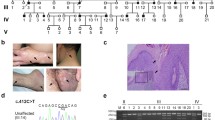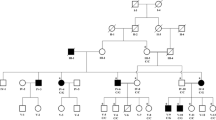Abstract
Disseminated superficial actinic porokeratosis (DSAP) is a chronic autosomal dominant cutaneous disorder with high genetic heterogeneity. Two genetic loci for DSAP were identified, but no specific genes were reported to date. The pathogenic mechanism of this disorder remains to be elucidated. In this study, a large, five-generation Chinese family with DSAP was genetically characterized. Two known DSAP loci, DSAP1 and DSAP2, two DSAP candidate genes (SART3 and SSH1), one DSP-linked locus and one PPPD-linked locus were first excluded in the family. The family was then characterized by genome-wide linkage analysis and a new DSAP locus was identified on chromosome 1p31.3–p31.1 with a maximum two-point LOD score of 5.09 with marker D1S2897 (θ = 0). Fine mapping showed that the disease gene was located within an 8.2 cM or 11.9 Mb region between markers D1S438 and D1S464. This is the third locus identified for DSAP (DSAP3). Eight candidate genes including GNG12, IL12RB2, ITGB3BP, DNAJ6, PIN1L, GADD45A, RPE65 and NEGR1 were sequenced, but found to be negative for functional sequence variants. Further mutational analysis of the candidate genes in the region will identify the specific gene for DSAP, which will provide insights into the pathogenesis of DSAP.



Similar content being viewed by others
Abbreviations
- DSAP:
-
Disseminated superficial actinic porokeratosis
- PCR:
-
Polymerase chain reaction
- LOD:
-
Logarithm of odds ratio
- SNP:
-
Single nucleotide polymorphism
References
Airoldi I, Di carlo E, Banelli B, Moserle L, Cocco C, Pezzolo A, Sorrentino C, Rossi E, Romani M, Amadori A, Pistoia V (2004) The IL-12Rbeta2 gene functions as a tumor suppressor in human B cell malignancies. J Clin Invest 113:1651–1659
Altomare DA, Testa JR (2005) Perturbations of the AKT signaling pathway in human cancer. Oncogene 24:7455–7464
Anzai S, Takeo N, Yamaguchi T, Sato T, Takasaki S, Terashi H, Takayasu S, Takahashi S (1999) Squamous cell carcinoma in a renal transplant recipient with linear porokeratiosis. J Dermatol 26:244–247
Besta F, Massberg S, Brand K, Muller E, Page S, Gruner S, Lorenz M, Sadoul K, Kolanus W, Lengyel E, Gawaz M (2002) Role of beta(3)-endonexin in the regulation of NF-kappaB-dependent expression of urokinase-type plasminogen activator receptor. J Cell Sci 115:3879–3888
Campbell HD, Webb GC, Fountain S, Young IG (1997) The human PIN1 peptidyl-prolyl cis/trans isomerase gene maps to human chromosome 19p13 and the closely related PIN1L gene to 1p31. Genomics 44:157–162
Frank J, van Geel M, van Steensel MA (2007) Loss of heterozygosity studies on chromosome 12q in disseminated superficial actinic porokeratosis: lessons to be learned. J Invest Dermatol 127:2058–2059
Hinterhuber G, Cauza K, Dingelmaier-Hovorka R, Diem E, Horvat R, Wolff K, Foedinger D (2005) Expression of RPE65, a putative receptor for plasma retinol-binding protein, in nonmelanocytic skin tumours. Br J Dermatol 153:785–789
Lathrop GM, Lalouel JM (1984) Easy calculations of lod scores and genetic risks on small computers. Am J Hum Genet 36:460–465
Mizukawa Y, Shiohara T (1999) Porokeratosis in patients with hepatitis C virus infection: does hepatitis C virus infection provide a link between porokeratosis and immunosuppression? Br J Dermatol 141:163–164
Neer EJ (1995) Heterotrimeric G proteins: organizers of transmembrane signals. Cell 80:249–257
Niwa R, Nagata-Ohashi K, Takeichi M, Mizuno K, Uemura T (2002) Control of actin reorganization by Slingshot, a family of phosphatases that dephosphorylate ADF/cofilin. Cell 108:233–246
Otsuka F, Shima A, Ishibashi Y (1989) Porokeratosis has neoplastic clones in the epidermis: microfluorometric analysis of DNA content of epidermal cell nuclei. J Invest Dermatol 92:231–233
Rio B, Magana C, Le Tourneau A, Bachmeyer C, Levy V, Hamont N, Diebold J, Zittoun R (1997) Disseminated superficial porokeratosis after autologous bone marrow transplantation. Bone Marrow Transplant 19:77–79
Schamroth JM, Zlotogorski A, Gilead L (1997) Porokeratosis of Mibelli: overview and review of literature. Acta Derm Venereol 77:207–213
Thyss R, Virolle V, Imbert V, Peyron JF, Aberdam D, Virolle T (2005) NF-kappaB/Egr-1/Gadd45 are sequentially activated upon UVB irradiation to mediate epidermal cell death. EMBO J 24:128–137
Vartiainen MK, Mustonen T, Mattila PK, Ojala PJ, Thesleff I, Partanen J, Lappalainen P (2002) The three mouse actin-depolymerizing factor/cofilins evolved to fulfill cell-type-specific requirements for actin dynamics. Mol Biol Cell 13:183–194
Wei SC, Yang S, Li M, Song YX, Zhang XQ, Bu L, Zheng GY, Kong XY Zhang XJ (2003) Identification of a locus for porokeratosis palmaris et plantaris disseminata to a 6.9-cM region at chromosome 12q24.1–24.2. Br J Dermatol 149:261–267
Wei S, Yang S, Lin D, Li M, Zhang X, Bu L, Zheng G, Hu L, Kong X, Zhang X (2004) A novel locus for disseminated superficial porokeratosis maps to chromosome 18p11.3. J Invest Dermatol 123:872–875
Xia JH, Yang YF, Deng H, Tang BS, Tang D, He YG, Xia K, Chen SX, Li YY, Pan Q, Long ZG, Dai HP, Liao SD, Xiao JF, Liu ZR, Lu CY, Yu KP, Deng HX (2000) Identification of a locus for disseminated superficial actinic porokeratosis at chromosome 12q23.2–24.1. J Invest Dermatol 114:1071–1074
Xia K, Deng H, Xia JH, Zheng D, Zhang HL, Lu CY, Li CQ, Pan Q, Dai HP, Yang YF, Long ZG, Deng HX (2002) A novel locus (DSAP2) for disseminated superficial actinic porokeratosis maps to chromosome 15q25.1–26.1. Br J Dermatol 147:650–654
Zhang Z, Niu Z, Yuan W, Liu W, Xiang L, Zhang J, Chu X, Zhao J, Jiang F, Chai B, Cui F, Wang Y, Zhang K, Wang Y, Xu S, Xia L, Gu J, Zhang S, Meng X, Wang S, Gao S, Fan M, Nie L, Zheng Z, Huang W (2004) Fine mapping and identification of a candidate gene SSH1 in disseminated superficial actinic porokeratosis. Hum Mutat 24:438
Zhang ZH, Niu ZM, Yuan WT, Zhao JJ, Jiang FX, Zhang J, Chai B, Cui F, Chen W, Lian CH, Xiang LH, Xu SJ, Liu WD, Zheng ZZ, Huang W (2005) A mutation in SART3 gene in a Chinese pedigree with disseminated superficial actinic porokeratosis. Br J Dermatol 152:658–663
Acknowledgments
We thank the patients and families for their enthusiastic participation. This study was supported by the China Natural Science Foundation grant 30571677(ML), 30670857 (QKW), and the Chinese Ministry of Science and Technology 863 Project grant No. 2006AA02Z476 (QKW). Q. K. Wang is an Established Investigator of the American Heart Association (0440157N).
Author information
Authors and Affiliations
Corresponding authors
Rights and permissions
About this article
Cite this article
Liu, P., Zhang, S., Yao, Q. et al. Identification of a genetic locus for autosomal dominant disseminated superficial actinic porokeratosis on chromosome 1p31.3–p31.1. Hum Genet 123, 507–513 (2008). https://doi.org/10.1007/s00439-008-0504-x
Received:
Accepted:
Published:
Issue Date:
DOI: https://doi.org/10.1007/s00439-008-0504-x




